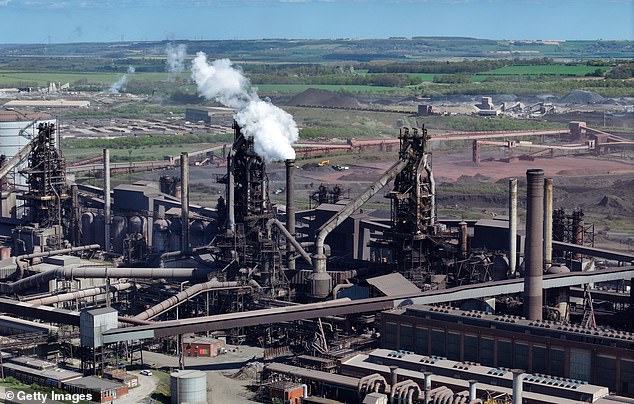Climate change can kill us by triggering land-ravaging wildfires, energy-sapping heatwaves and violent tropical storms.
But according to a new study, more than half a million Europeans could be killed every year by 2050 just by breathing the air.
Scientists at the University of Leeds warn that greenhouse gas emissions from cars, power plants and more can kill us by making the air toxic.
Up to 250,000 deaths from poor air quality could be prevented annually in central and western Europe by 2050 if emissions are drastically reduced, they reveal.
But this reduction can only be made if there is a strong focus on reducing greenhouse gases and the associated air pollutants starting from now.
Poor air quality is the largest environmental risk factor for early deaths leading to an estimated 8 million deaths per year globally, according to recent analysis by the World Bank and the World Economic Forum.
‘Europe has quite a high air quality mortality rate because of the density and large degree of urbanisation,’ study author Connor Clayton, a PhD student at the University of Leeds, told MailOnline.
‘This work was designed to hopefully show policymakers that stringent climate change mitigation can have local benefits.

Up to 250,000 deaths from poor air quality could be prevented annually in central and western Europe by 2050 if greenhouse gas emissions are drastically reduced, say experts. They focused on two death-causing pollutants including PM2.5 which comes from coal-burning power plants and other industrial sources. Pictured, blast furnaces at British Steel Scunthorpe

Graphs predict the annual change in deaths from ozone (O3) in 2014 (a) and by 2050 under high emissions scenario (b), medium emissions scenario (c) and low emissions scenario (d)
‘Europe has a very high density of governments that this may be of interest to.’
The new study focused on two pollutants in the air – invisible fine particulate matter (PM2.5) and surface level ozone (O3).
Ozone forms when heat and sunlight interact with greenhouse gases such as nitrous oxide, carbon monoxide and volatile organic compounds released during the burning of fossil fuels.
Breathing in ozone – which creates a distinctive ‘smog’ over cities – is known to worsen respiratory and cardiovascular illnesses, and has been linked to increased mortality rates.
PM2.5, meanwhile, can enter the lungs and then the bloodstream, lodging in the heart, brain and other organs.
It’s thought breathed-in PM2.5 can trigger changes linked with different diseases such as Parkinson’s, diabetes, lung cancer, chronic obstructive pulmonary disease (COPD) and heart disease, as well as impacts on reproductive and foetal health.
According to the scientists, PM 2.5 comes from planet-polluting sources such as motor vehicles, coal-burning power plants and other industrial sources.

Ozone (O3) causes a smoggy haze that can damage the lungs. Ozone is most likely to reach unhealthy levels on hot sunny days in urban environments. Pictured is smog over London

Coal-burning power plants are a major source of fine particulate matter (PM2.5) air pollution. Pictured, a power plant that produces electricity from coal, Rovinari, southern Romania

Graphs predict the annual change in deaths from PM2.5 in 2014 (a) and by 2050 under high emissions scenario (b), medium emissions scenario (c), and low emissions scenario (d)
‘Greenhouse gas emissions do not directly create PM2.5, but they come from the same sources,’ said Clayton.
‘Thus, mitigation of greenhouse gases is beneficial for particulate air quality (depending on the source of the emissions).’
The team used computer modelling to simulate future air quality and predict the resulting health impacts of ozone and PM2.5.
To predict air quality of the future, they looked at three scenarios (low, medium and high) where various levels of action are taken by policymakers to combat these two pollutants.
In the present day, there are already 444,000 deaths per year from PM2.5 and 23,000 per year from ozone.
Under the low emissions scenario, in Europe there would be 199,000 deaths per year from PM2.5 and 17,000 deaths per year from ozone by 2050.
Under the medium emissions scenario, there would be 455,000 deaths from PM2.5 and 47,000 from ozone per year.
And under the high emissions scenario, there would be a whopping 456,000 deaths from PM2.5 per year and 50,000 deaths from ozone per year – a total of 506,000.

Common pollutants from diesel include unburned hydrocarbons (HC), carbon monoxide (CO), nitrogen oxides (NOx) and particulate matter (PM)
Using current fatality data and projections under the low emissions scenario, the team estimate that 250,000 deaths per year could be avoided.
‘Only high mitigation reduces the absolute number of projected air quality deaths in Europe,’ Dr Clayton told MailOnline.
Deprived regions of Europe currently have proportionally higher death rates from air pollution than less deprived regions but that reductions in emissions would reduce that inequity.
For example, PM2.5 was usually higher in central and eastern Europe than in western Europe, with particularly high concentrations in the Po Valley in Italy, in Bosnia and Herzegovina, and in southern Poland. But that this inequity is reduced following greater climate change mitigation.
The findings, published in the journal Earth’s Future, show how air pollution is just one way the fatal effects of greenhouse gas emissions can manifest.
Study leader Dr Jim McQuaid, atmospheric scientists at the University of Leeds, said climate warming gases and aerosols are ‘very much two sides of the same coin’.
‘This work provides evidence that there are direct health benefits from moving towards a low carbon economy,’ he said.
This article was originally published by a www.dailymail.co.uk . Read the Original article here. .


